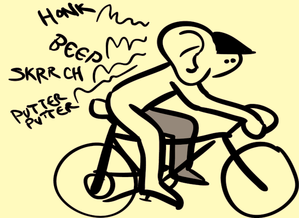The role of auditory information in cycling safety
Subject
Auditory perception is considered to play an important role for cyclists, especially for gathering information about approaching vehicles from areas outside one’s field of view or when visibility is obstructed. However, fundamental research into the role of auditory information for safe cycling is lacking. The objective of this PhD project is to fill in this knowledge gap. Specifically, this project investigates to what extent reduced auditory input while cycling constitutes a hazard for teenage, middle-aged and older cyclists. The interest in this topic has been generated by two growing trends: the increasing preoccupation with electronic media devices by road users and the rising number of quiet electric vehicles on the road. When having a conversation on the phone or listening to music presumably less or no auditory cues from the traffic environment can reach the cyclist. Generally, electric cars are quieter than conventional cars, especially when driven at low speeds. Due to their quietness slow-moving electric cars are more difficult to detect than traditional vehicles. The combination of both could result critical situations because cyclists miss auditory cues to be able to move around safely.
Scientific challenges
The biggest scientific challenge is to determine the impact of device use or quietness of electric cars on cyclists’ crash involvement. The Dutch official crash databases cannot be used as they are not detailed enough, and most often do not contain information on usage of mobile phones or other electronic devices during or prior to an accident, while the use of subjective assessments to calculate crash involvement has important disadvantages, e.g. possible non-accurate recall, dishonest reporting or selective non-response bias.

Illustration by Noah Adler
Societal relevance
The findings of this project have implications for cycling safety and safety measures that could be taken. In various countries a number of countermeasures have recently been proposed or already taken to protect cyclists, for example a ban on cyclists wearing headphones, minimum sound requirements for (electric) cars, or pedestrian/cyclist detection systems. However, the suitability of these solutions from the perspective of cycling safety has not been established yet. Based on the knowledge about the use of auditory cues while cycling gathered in this project, we can provide a starting point for developing effective countermeasures to protect cyclists.
Agnieszka StellingStart/end date: 1st January, 2013 - 2017Daily supervisor: Marjan Hagenzieker Promotor: Marjan Hagenzieker, Bert van Wee |